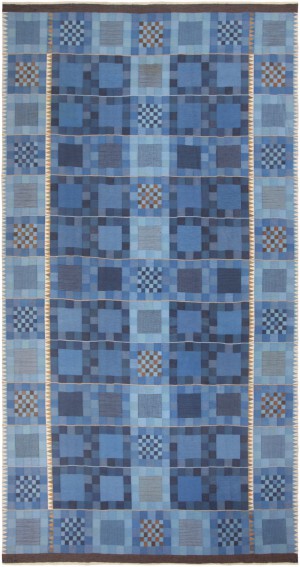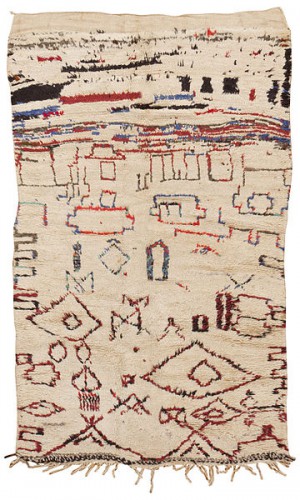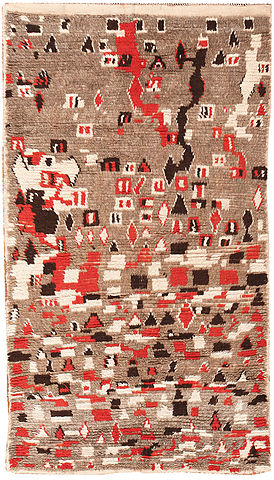Vintage rugs feature fanciful, abstract and colorful motifs and they were influenced by the most prominent artistic styles and movements of the past century like art deco, cubism, art nouveau, and modernism.
Home décor is like fashion. Retro trends in fashion and interior design lately made a comeback in a big way. If you plan to give your home a vintage makeover, you will have to mingle particular motifs and materials in order to create a unique retro style. There are many ways for giving to your house that classical feel. You can use old furniture, vintage wallpaper, different fabrics and other elements. A vintage rug can be one of them.
Rugs are indispensable accessories for the house because they fill empty space properly as well as they add a sense of warmth and softness to a home. In most of cases rugs are considered as the accessory from around which the entire design of a room depends on. There are countless vintage rugs produced during the mid-20th century that can be used since the modern 20th century styles have become important when it comes to vintage furniture. These rugs feature fanciful, abstract and colorful motifs. Vintage rugs were influenced by the most prominent artistic styles and movements of the past century like art deco, cubism, art nouveau, modernism etc.
The designers aim was to experiment new sensations in terms of sensory experience. Hence, rugs design evolved from traditional to a modern and elegant style conforming to the new trends of the time based on abstract motifs. Those new trends were applied not only to rugs and carpets produced in European countries but even to those that were made in oriental countries that have always been considered as the origin of traditional rugs and carpets.
Vintage rugs are characterized by experimentation. They replaced the expensive traditional rugs with new gorgeous fresh style motifs. These rugs are apt for the people that want to change completely the atmosphere in their house.
The Evolution of Vintage Rug Design
Vintage rugs not only embody the aesthetic shifts of the 20th century but also represent a significant evolution in design philosophy. As societies moved through the tumultuous times of the 20th century, the art and design landscape underwent radical changes. This period saw the rise of industrialization, which democratized design and introduced new materials and mass production techniques. Vintage rugs from this era reflect these changes, showcasing both the influence of high art movements and the practicalities of new manufacturing methods.
The Influence of Global Traditions
While European designers were pushing the boundaries of modernism, there was a parallel movement that looked beyond the West for inspiration. The incorporation of motifs and techniques from places like Persia, Turkey, and the Far East into vintage rugs highlights a fusion of global design traditions. This cross-cultural exchange enriched the design vocabulary of vintage rugs, adding layers of meaning and a broader palette of styles for designers and homeowners to draw from.
Choosing the Perfect Vintage Rug
Selecting a vintage rug requires a keen eye for quality, an appreciation for historical context, and an understanding of your own space’s aesthetic needs. It’s about finding a piece that speaks to you, but also one that fits harmoniously within your home. Consider factors like color, pattern, size, and the overall condition of the rug. Each vintage rug carries its own story, with wear and patina that add character and depth.
Care and Maintenance of Vintage Rugs
Preserving the beauty of a vintage rug requires specific care and attention. Due to their age and the nature of their materials, these rugs can be delicate. Regular vacuuming with a brushless attachment, immediate attention to spills, and professional cleanings can extend the life of a vintage rug. It’s also crucial to protect them from prolonged exposure to direct sunlight to prevent fading.
The Role of Vintage Rugs in Contemporary Interiors
In modern interior design, vintage rugs serve as a bridge between the past and present. They add texture, color, and personality to a room, making a statement that is both timeless and distinctly individual. Designers often use vintage rugs to ground a space, allowing contemporary furniture and art to stand out against the rug’s rich historical backdrop.
Sustainability and Vintage Rugs
In today’s environmentally conscious world, choosing a vintage rug is a sustainable option. By repurposing existing pieces, we reduce the demand for new productions, lowering our carbon footprint. Vintage rugs are the epitome of sustainable decor, offering a way to decorate responsibly while enjoying the unique beauty and quality of these historical pieces.
How to Incorporate Vintage Rugs into Your Home
Integrating a vintage rug into your home decor involves more than just placing it in a room. It’s about creating a dialogue between the rug and its surroundings. Whether it’s juxtaposing a brightly colored mid-century rug against minimalist furniture or using a classic Art Deco piece to add elegance to a modern room, the key is in the balance. Consider the rug as the foundation of your space’s color scheme or as a focal point that dictates the room’s mood and style.
The Timeless Appeal of Vintage Rugs
Ultimately, the allure of vintage rugs lies in their ability to transcend trends. They are pieces of art that floor your space—quite literally—with history, craftsmanship, and beauty. Whether you’re a collector, a design enthusiast, or someone looking to add a touch of history to your home, a vintage rug is a choice that you’ll cherish for years to come.
FAQ
-
How do I identify an authentic vintage rug? Look for signs of age, unique design elements, and craftsmanship details. Consulting with an expert can also provide valuable insights.
-
Can vintage rugs be repaired? Yes, professional restorers can repair many types of damage, preserving the rug’s beauty and extending its life.
- Are vintage rugs a good investment? Many vintage rugs appreciate in value, especially those that are rare or in excellent condition. However, their true value often lies in their aesthetic and historical significance.






